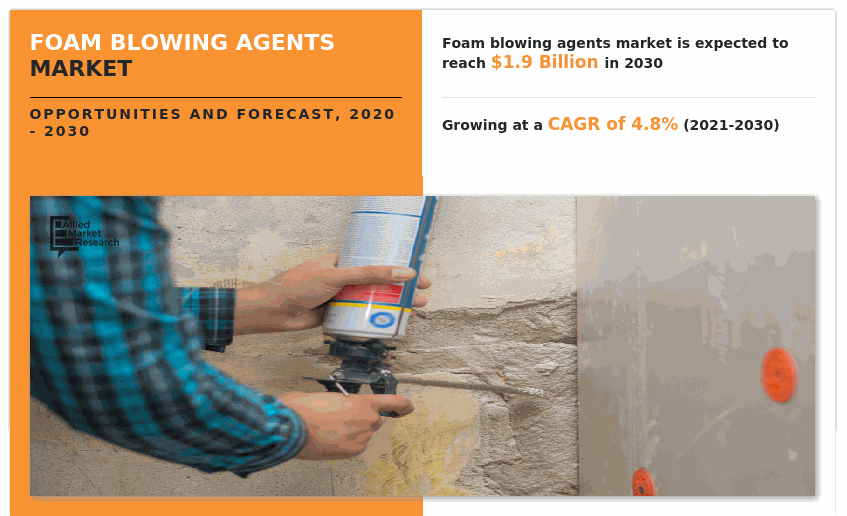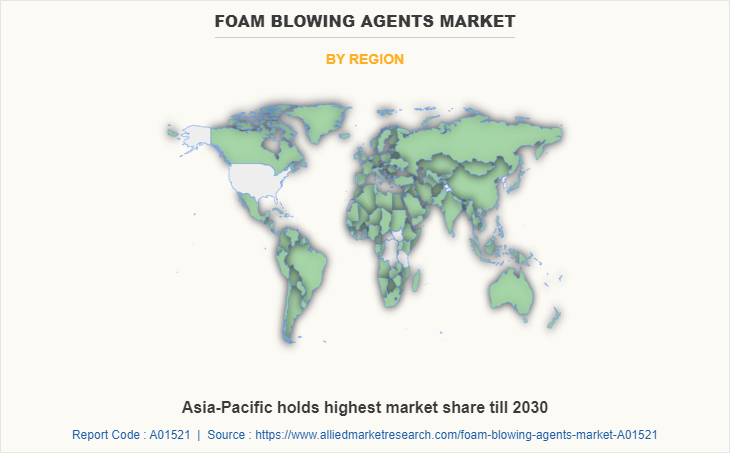Foam Blowing Agents Market Research, 2030
The global foam blowing agents market was valued at $1.2 billion in 2020, and is projected to reach $1.9 billion by 2030, growing at a CAGR of 4.8% from 2021 to 2030.

Foam blowing agents have become essential ingredients used in foam substrates and provide cellular structure for the material. The foam of the polymer provides advantages such as heat and acoustic insulation, low reduction rate of the product, and small amount of material. Further, the foam blowing agents has the opportunity to be used in various environmentally friendly products such as methyl formate, HFO, and methylal. Furthermore, owing to low global warming potential(GWP), zero ozone depletion (OPD), non-toxic and direct foaming agents were introduced, resulting in a revolution in foam blowing agents. The foam blowing agents market is expected to exhibit a significant increase due to the competitive advantage of foaming agents such as efficiency, environmentally friendly, and the best isolation characteristics. The surgein the usage of polymer foams in the construction and automotive sector is anticipated to rise in the next few years.
The global foam market is operated by life-level growth and the growth of purchasing power has derived the development of the flooring and furniture industries in recent years. Hospitality products require excellent high-quality grade and aesthetic furniture. The polymer foam absorbs shock, water on furniture, and provides the aesthetic appearance of quality improvement. The foam blowing market is expected to grow in the floor and furniture industry as the adoption of polymer foam increases. Its usage in the construction sector has increased moderately over the past five years and is expected to grow significantly in the next few years. Global population growth and rise in average disposable income further drive the development of the construction industry in developing countries. Polymer foams are widely used in construction. However, pollution controls introduced by governments in different regions and various organizations are expected to hamper the growth of the market.
The foam blowing agents market is segmented on the basis of type, application, and region.
On the basis of type, the market is categorized into hydrocarbons, hydrofluorocarbons, hydrochlorofluorocarbons, and others (that includes hydrofluoroolefins, methyl formate, liquid CO2, and water). By applications, the market is bifurcated into polyurethane, polystyrene, polyolefins, and others (that include phenolic foams and polyvinyl chloride). By region, the market is analyzed across North America, Europe, Asia-Pacific, and LAMEA. The Asia-Pacific region accounted for more than 45% share of the total revenue in 2020, followed by North America and Europe.The applications of foam blowing agents in the construction and automotive industries such as for building insulation and as sealants for windows &doors drive the foam blowing agents market in North America.
The key players operating in the global foam blowing agents market include Arkema S.A. (France), Honeywell International Inc. (U.S.), Exxon Mobil Corporation (U.S.), E.I. du Pont de Nemours & Company (U.S.), Haltermann GmbH (Germany), Harp International Ltd. (U.K.), Daikin Industries, Ltd. (Japan), Sinochem Group (China), Solvay S.A. (Germany), and ZEON Corporation (Japan).
The other prominent foam blowing agents industry players include Linde AG (Germany), AkzoNobel N.V., Lychem International Co., Limited, BEO International, SPL Group, KSJN Catalyzing Industries, Sunwell Global Ltd., Marubeni Corporation, and Astra Polymers that compete for the share of the market through product launch, joint venture, partnership, and expansion of the production capabilities to meet the future demand for foam blowing agents market during the forecast period.

Asia-Pacific occupies the largest part of the foam blowing agents market and consists of countries such as China, India, Japan, South Korea, Australia, and rest of Asia-Pacific.Asia-Pacific continues to be a favorable region for foaming agents in terms of both value and quantity. Population growth combined with increased housing and construction activity is expected to drive demand for polyurethane foams and other foaming agents in the near future. In addition, the rapid urbanization and population growth of countries such as China, India and Japan have increased the demand for insulation applications, thereby fostering the overall production and consumption of foaming agents in the region. In addition, China's construction industry has grown significantly over the last decade, driven by a surge in real estate investment and huge infrastructure investment.
By Product Type
Hydrocarbons segment will possess high incremental $ opportunity from 2021 till 2030
The hydrocarbons segment dominates the global foam blowing agents market. Hydrocarbon-based products have experienced maximum demand in a variety of applications such as refrigeration, wall cladding, and roofing due to their zero global warming potential (GWP) and negligible ozone depletion potential (ODP) compared to fluorocarbons. In addition, the 2016 Montreal Protocol mandates the phasing out of HFC production and consumption in developing countries by 2024, paving the way for hydrocarbons and other green foaming agents. Hydrocarbons are widely used in polyurethane foams in various end-use industries such as automobiles, home appliances, construction, flooring, and furniture.
By Applications
Polyurethane segment is expected to be most lucrative segment till 2030
The polyurethane segment dominates the global foam blowing agents market. Environmental benefits associated with polyurethane foam such as low greenhouse gas emissions and increasing popularity of the application of polyurethane as moisture and mould resistant materials have driven the market growth. In addition, important properties such as rise inflexibility make it an excellent insulation material for buildings, driving market demand. In addition, demand from the oil &gas and automotive industries are expected to be a major driver of polyurethane sales growth. For example, in the oil and gas industry, polyurethane has its uses to protect pipelines for smooth operation. Owing to the above factors, it is expected to hold a large market share during the forecast period from 2021 to 2030.
COVID-19 Impact Analysis:
COVID-19 has severely impacted the global economy with devastating effects on global trade, which has simultaneously affected households, business, financial institution, industrial establishments, and infrastructure companies. The spread of COVID-19 has moderate impact on this market. Suspension of all manufacturing and production activity was majorly responsible for the dim demand prospects during the outbreak of COVID-19 pandemic. The stringent government regulations toward the shutdown of transportation sector have led to increase in difficulty in the procurement of the raw materials. The outbreak of the pandemic has led to the decline in efficiency at the manufacturing sites due to the low labor force.
Key Benefits For Stakeholders
- This report provides a quantitative analysis of the market segments, current trends, estimations, and dynamics of the foam blowing agents market analysis from 2020 to 2030 to identify the prevailing foam blowing agents market opportunities.
- The market research is offered along with information related to key drivers, restraints, and opportunities.
- Porter's five forces analysis highlights the potency of buyers and suppliers to enable stakeholders make profit-oriented business decisions and strengthen their supplier-buyer network.
- In-depth analysis of the foam blowing agents market segmentation assists to determine the prevailing market opportunities.
- Major countries in each region are mapped according to their revenue contribution to the global market.
- Market player positioning facilitates benchmarking and provides a clear understanding of the present position of the market players.
- The report includes the analysis of the regional as well as global foam blowing agents market trends, key players, market segments, application areas, and market growth strategies.
Foam Blowing Agents Market Report Highlights
| Aspects | Details |
| By Applications |
|
| By Product Type |
|
| By Region |
|
| Key Market Players | SINOCHEM GROUP (CHINA), ARKEMA S.A. (FRANCE), HONEYWELL INTERNATIONAL INC. (U.S.), ZEON CORPORATION (JAPAN), SOLVAY S.A. (GERMANY), LTD. (JAPAN), LTD. (JAPAN), EXXON MOBIL CORPORATION (U.S.), DAIKIN INDUSTRIES, HARP INTERNATIONAL LTD. (U.K.), E.I. DU PONT DE NEMOURS & COMPANY (U.S.), HALTERMANN GMBH (GERMANY) |
Analyst Review
Foam blowing agents have become an essential ingredient used in foaming substrates to give the material a foam structure. Polymer foam offers benefits such as thermal insulation & soundproofing, lighter final products, and lower material consumption. In addition, foam blowing agents have the potential to be used in a variety of eco-friendly products such as methyl formate, HFO, and methyl. In addition, the introduction of non-toxic, non-flammable, low global warming potential (GWP), and zero ozone layer destruction (OLD) foaming agents has revolutionized the foam blowing agent market. Foam blowing agents are primarily used in polyurethane foam. Polyurethane foam is used in industries such as automotive, construction, flooring, furniture, medical devices, and packaging.
The combination of rapid industrialization and infrastructure development drives the growth of the construction industry around the world. In addition, improved living standards and disposable income augment the hospitality industry, including hotels, malls, and spas, and promoting the construction industry. The growth of these industries has a positive impact on the development of the foam blowing agent market.
The construction sector has grown moderately over the last five years and is expected to grow significantly over the next few years. Global population growth and rise in average disposable income further boost the construction industry in Vietnam, China, India, Malaysia, and Indonesia. Polymer foam is widely used in construction. In recent years, the flooring and furniture industry has developed due to rise in living standards and surge in purchasing power parity. The booming hospitality industry demands exceptional quality floors and aesthetically pleasing furniture. Polymer foam is used in flooring and furniture to absorb shock and provide a high-quality aesthetic appearance. The foam blowing agent market in the flooring and furniture industry is expected to grow promisingly due to increased adoption of polymer foam.
Growth of the construction and automotive industries and increased manufacturing of polyurethane foams are the key factors boosting the Foam Blowing Agents market growth
The market value of Foam Blowing Agents in 2030 is expected to be US$ 1.9 Billion
Arkema S.A. (France), Honeywell International Inc. (U.S.), Exxon Mobil Corporation (U.S.), E.I. du Pont de Nemours & Company (U.S.), Haltermann GmbH (Germany), Harp International Ltd. (U.K.), Daikin Industries, Ltd. (Japan), Sinochem Group (China), Solvay S.A. (Germany), and ZEON Corporation (Japan).
Construction and automotive industry is projected to increase the demand for Foam Blowing Agents Market
The foam blowing agents market is segmented on the basis of type, application, and region. On the basis of type, the market is categorized into hydrocarbons, hydrofluorocarbons, hydrochlorofluorocarbons, and others. By applications, the market is bifurcated into polyurethane, polystyrene, polyolefins, and others. By region, the market is analyzed across North America, Europe, Asia-Pacific, and LAMEA.
Improvement in energy efficiency of foam blowing agents is the Main Driver of Foam Blowing Agents Market
Construction and automotive industry are expected to drive the adoption of Foam Blowing Agents
The spread of COVID-19 has moderate impact on this market. Suspension of all manufacturing and production activity was majorly responsible for the dim demand prospects during the outbreak of COVID-19 pandemic. The stringent government regulations toward the shutdown of transportation sector have led to increase in difficulty in the procurement of the raw materials.
Loading Table Of Content...


